International Trade Relations: Evaluating AIH Company in Global Market
VerifiedAdded on 2023/06/14
|5
|1238
|296
Essay
AI Summary
This essay provides a comprehensive analysis of international trade relations, focusing on the Australian international investment company, Australian International Holdings Limited (AIH). It examines the international business environment in which AIH operates, highlighting the stable economies of Australia, America, the UK, and New Zealand. The essay discusses AIH's financial performance, investment strategies, and the mechanisms that regulate international trade, such as the World Trade Organization (WTO) and International Trade Commission (ITC). Furthermore, it explores factors that restrict or encourage international trade, including trade agreements, tariffs, and non-tariff barriers. The essay also addresses the problems encountered by countries when entering new markets, such as cultural differences, trade barriers, and financial risks, and discusses various market entry methods. The analysis draws upon academic sources to provide a well-rounded perspective on international trade and its implications for companies like AIH.
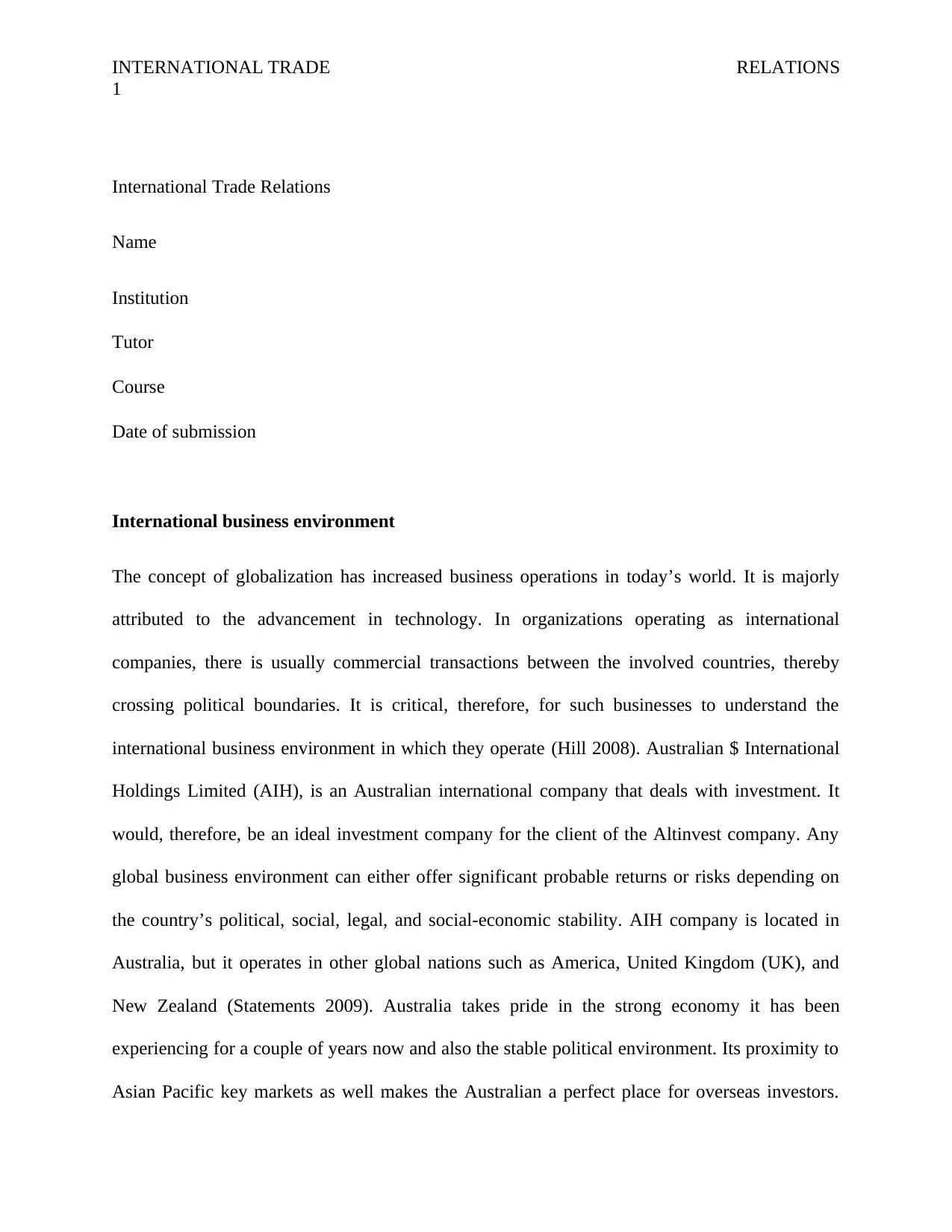
INTERNATIONAL TRADE RELATIONS
1
International Trade Relations
Name
Institution
Tutor
Course
Date of submission
International business environment
The concept of globalization has increased business operations in today’s world. It is majorly
attributed to the advancement in technology. In organizations operating as international
companies, there is usually commercial transactions between the involved countries, thereby
crossing political boundaries. It is critical, therefore, for such businesses to understand the
international business environment in which they operate (Hill 2008). Australian $ International
Holdings Limited (AIH), is an Australian international company that deals with investment. It
would, therefore, be an ideal investment company for the client of the Altinvest company. Any
global business environment can either offer significant probable returns or risks depending on
the country’s political, social, legal, and social-economic stability. AIH company is located in
Australia, but it operates in other global nations such as America, United Kingdom (UK), and
New Zealand (Statements 2009). Australia takes pride in the strong economy it has been
experiencing for a couple of years now and also the stable political environment. Its proximity to
Asian Pacific key markets as well makes the Australian a perfect place for overseas investors.
1
International Trade Relations
Name
Institution
Tutor
Course
Date of submission
International business environment
The concept of globalization has increased business operations in today’s world. It is majorly
attributed to the advancement in technology. In organizations operating as international
companies, there is usually commercial transactions between the involved countries, thereby
crossing political boundaries. It is critical, therefore, for such businesses to understand the
international business environment in which they operate (Hill 2008). Australian $ International
Holdings Limited (AIH), is an Australian international company that deals with investment. It
would, therefore, be an ideal investment company for the client of the Altinvest company. Any
global business environment can either offer significant probable returns or risks depending on
the country’s political, social, legal, and social-economic stability. AIH company is located in
Australia, but it operates in other global nations such as America, United Kingdom (UK), and
New Zealand (Statements 2009). Australia takes pride in the strong economy it has been
experiencing for a couple of years now and also the stable political environment. Its proximity to
Asian Pacific key markets as well makes the Australian a perfect place for overseas investors.
Paraphrase This Document
Need a fresh take? Get an instant paraphrase of this document with our AI Paraphraser
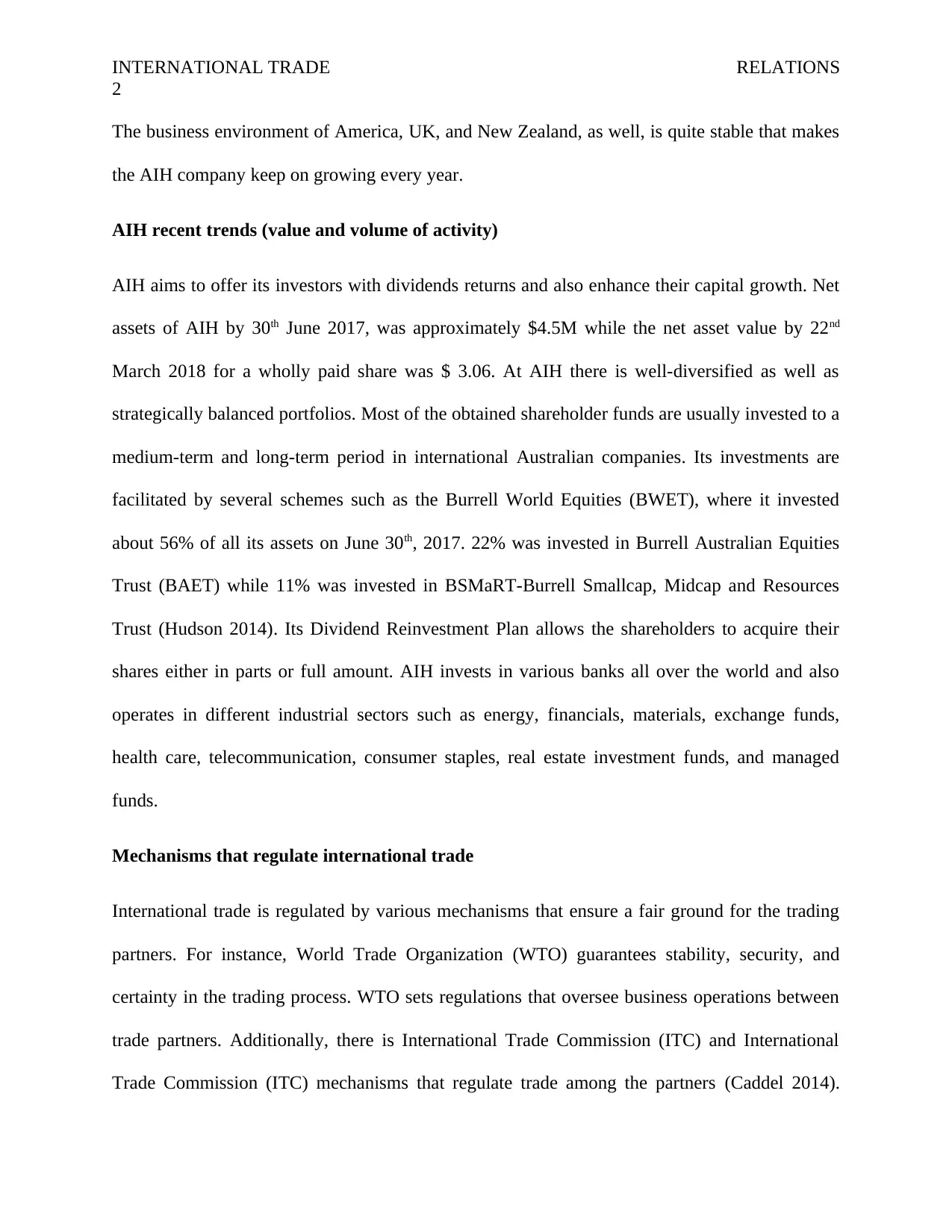
INTERNATIONAL TRADE RELATIONS
2
The business environment of America, UK, and New Zealand, as well, is quite stable that makes
the AIH company keep on growing every year.
AIH recent trends (value and volume of activity)
AIH aims to offer its investors with dividends returns and also enhance their capital growth. Net
assets of AIH by 30th June 2017, was approximately $4.5M while the net asset value by 22nd
March 2018 for a wholly paid share was $ 3.06. At AIH there is well-diversified as well as
strategically balanced portfolios. Most of the obtained shareholder funds are usually invested to a
medium-term and long-term period in international Australian companies. Its investments are
facilitated by several schemes such as the Burrell World Equities (BWET), where it invested
about 56% of all its assets on June 30th, 2017. 22% was invested in Burrell Australian Equities
Trust (BAET) while 11% was invested in BSMaRT-Burrell Smallcap, Midcap and Resources
Trust (Hudson 2014). Its Dividend Reinvestment Plan allows the shareholders to acquire their
shares either in parts or full amount. AIH invests in various banks all over the world and also
operates in different industrial sectors such as energy, financials, materials, exchange funds,
health care, telecommunication, consumer staples, real estate investment funds, and managed
funds.
Mechanisms that regulate international trade
International trade is regulated by various mechanisms that ensure a fair ground for the trading
partners. For instance, World Trade Organization (WTO) guarantees stability, security, and
certainty in the trading process. WTO sets regulations that oversee business operations between
trade partners. Additionally, there is International Trade Commission (ITC) and International
Trade Commission (ITC) mechanisms that regulate trade among the partners (Caddel 2014).
2
The business environment of America, UK, and New Zealand, as well, is quite stable that makes
the AIH company keep on growing every year.
AIH recent trends (value and volume of activity)
AIH aims to offer its investors with dividends returns and also enhance their capital growth. Net
assets of AIH by 30th June 2017, was approximately $4.5M while the net asset value by 22nd
March 2018 for a wholly paid share was $ 3.06. At AIH there is well-diversified as well as
strategically balanced portfolios. Most of the obtained shareholder funds are usually invested to a
medium-term and long-term period in international Australian companies. Its investments are
facilitated by several schemes such as the Burrell World Equities (BWET), where it invested
about 56% of all its assets on June 30th, 2017. 22% was invested in Burrell Australian Equities
Trust (BAET) while 11% was invested in BSMaRT-Burrell Smallcap, Midcap and Resources
Trust (Hudson 2014). Its Dividend Reinvestment Plan allows the shareholders to acquire their
shares either in parts or full amount. AIH invests in various banks all over the world and also
operates in different industrial sectors such as energy, financials, materials, exchange funds,
health care, telecommunication, consumer staples, real estate investment funds, and managed
funds.
Mechanisms that regulate international trade
International trade is regulated by various mechanisms that ensure a fair ground for the trading
partners. For instance, World Trade Organization (WTO) guarantees stability, security, and
certainty in the trading process. WTO sets regulations that oversee business operations between
trade partners. Additionally, there is International Trade Commission (ITC) and International
Trade Commission (ITC) mechanisms that regulate trade among the partners (Caddel 2014).
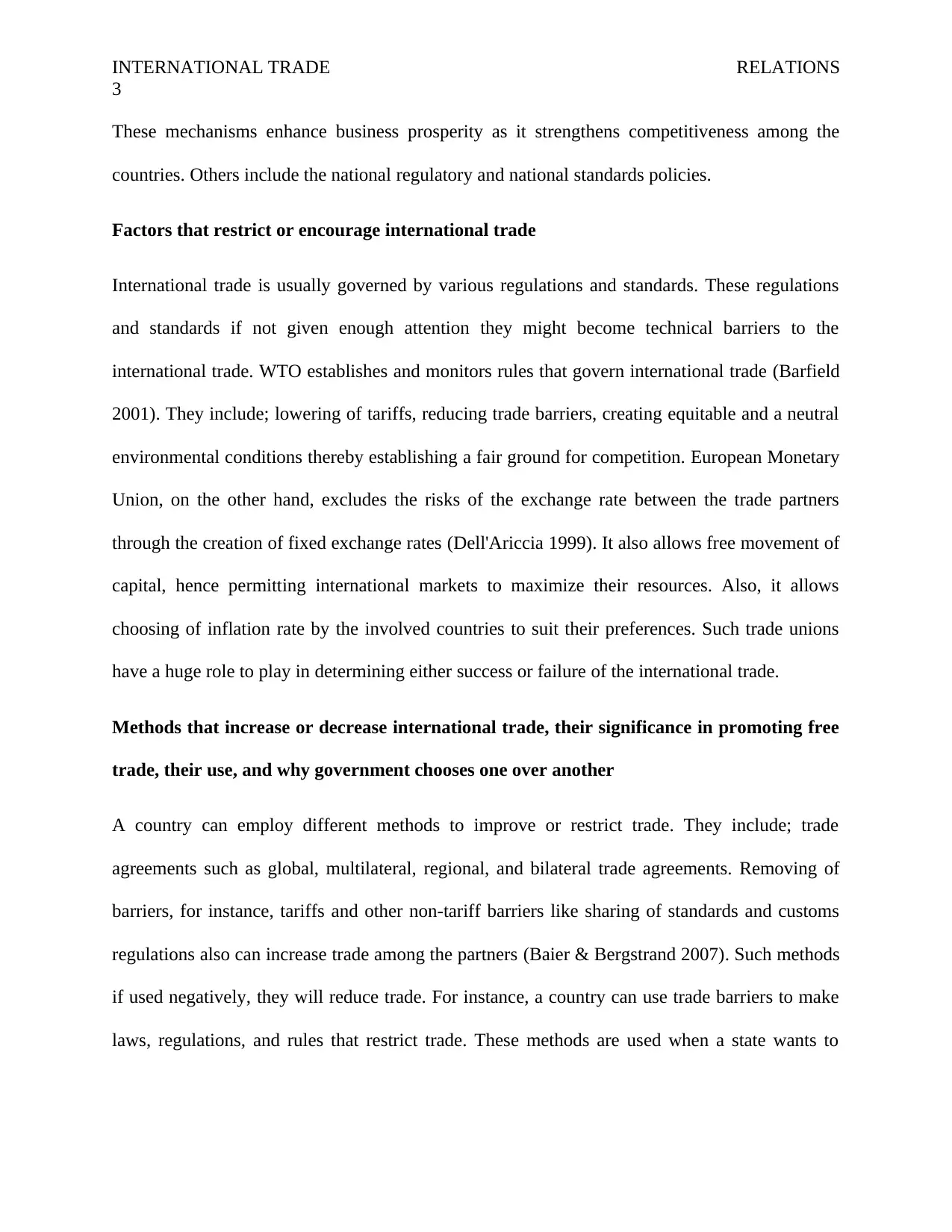
INTERNATIONAL TRADE RELATIONS
3
These mechanisms enhance business prosperity as it strengthens competitiveness among the
countries. Others include the national regulatory and national standards policies.
Factors that restrict or encourage international trade
International trade is usually governed by various regulations and standards. These regulations
and standards if not given enough attention they might become technical barriers to the
international trade. WTO establishes and monitors rules that govern international trade (Barfield
2001). They include; lowering of tariffs, reducing trade barriers, creating equitable and a neutral
environmental conditions thereby establishing a fair ground for competition. European Monetary
Union, on the other hand, excludes the risks of the exchange rate between the trade partners
through the creation of fixed exchange rates (Dell'Ariccia 1999). It also allows free movement of
capital, hence permitting international markets to maximize their resources. Also, it allows
choosing of inflation rate by the involved countries to suit their preferences. Such trade unions
have a huge role to play in determining either success or failure of the international trade.
Methods that increase or decrease international trade, their significance in promoting free
trade, their use, and why government chooses one over another
A country can employ different methods to improve or restrict trade. They include; trade
agreements such as global, multilateral, regional, and bilateral trade agreements. Removing of
barriers, for instance, tariffs and other non-tariff barriers like sharing of standards and customs
regulations also can increase trade among the partners (Baier & Bergstrand 2007). Such methods
if used negatively, they will reduce trade. For instance, a country can use trade barriers to make
laws, regulations, and rules that restrict trade. These methods are used when a state wants to
3
These mechanisms enhance business prosperity as it strengthens competitiveness among the
countries. Others include the national regulatory and national standards policies.
Factors that restrict or encourage international trade
International trade is usually governed by various regulations and standards. These regulations
and standards if not given enough attention they might become technical barriers to the
international trade. WTO establishes and monitors rules that govern international trade (Barfield
2001). They include; lowering of tariffs, reducing trade barriers, creating equitable and a neutral
environmental conditions thereby establishing a fair ground for competition. European Monetary
Union, on the other hand, excludes the risks of the exchange rate between the trade partners
through the creation of fixed exchange rates (Dell'Ariccia 1999). It also allows free movement of
capital, hence permitting international markets to maximize their resources. Also, it allows
choosing of inflation rate by the involved countries to suit their preferences. Such trade unions
have a huge role to play in determining either success or failure of the international trade.
Methods that increase or decrease international trade, their significance in promoting free
trade, their use, and why government chooses one over another
A country can employ different methods to improve or restrict trade. They include; trade
agreements such as global, multilateral, regional, and bilateral trade agreements. Removing of
barriers, for instance, tariffs and other non-tariff barriers like sharing of standards and customs
regulations also can increase trade among the partners (Baier & Bergstrand 2007). Such methods
if used negatively, they will reduce trade. For instance, a country can use trade barriers to make
laws, regulations, and rules that restrict trade. These methods are used when a state wants to
⊘ This is a preview!⊘
Do you want full access?
Subscribe today to unlock all pages.

Trusted by 1+ million students worldwide
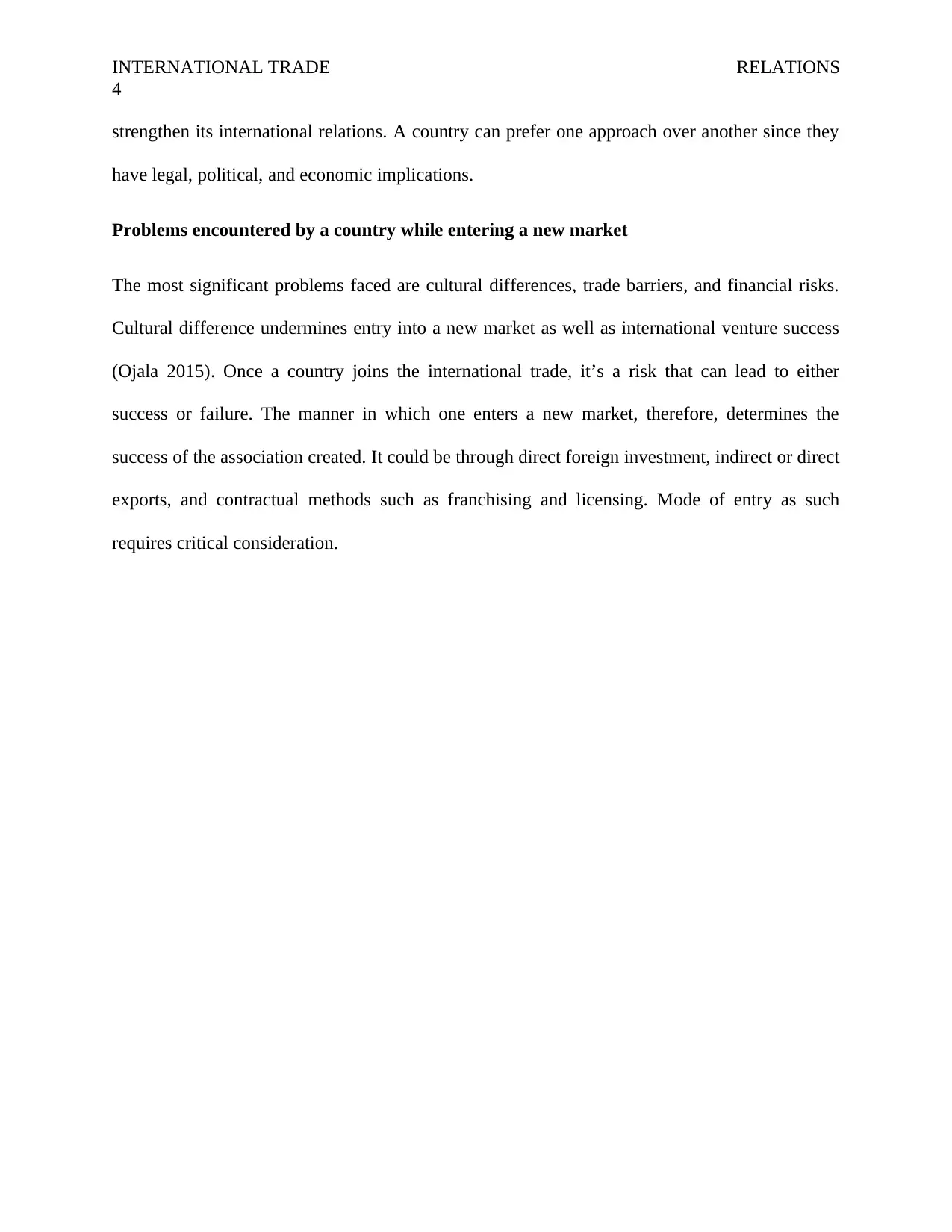
INTERNATIONAL TRADE RELATIONS
4
strengthen its international relations. A country can prefer one approach over another since they
have legal, political, and economic implications.
Problems encountered by a country while entering a new market
The most significant problems faced are cultural differences, trade barriers, and financial risks.
Cultural difference undermines entry into a new market as well as international venture success
(Ojala 2015). Once a country joins the international trade, it’s a risk that can lead to either
success or failure. The manner in which one enters a new market, therefore, determines the
success of the association created. It could be through direct foreign investment, indirect or direct
exports, and contractual methods such as franchising and licensing. Mode of entry as such
requires critical consideration.
4
strengthen its international relations. A country can prefer one approach over another since they
have legal, political, and economic implications.
Problems encountered by a country while entering a new market
The most significant problems faced are cultural differences, trade barriers, and financial risks.
Cultural difference undermines entry into a new market as well as international venture success
(Ojala 2015). Once a country joins the international trade, it’s a risk that can lead to either
success or failure. The manner in which one enters a new market, therefore, determines the
success of the association created. It could be through direct foreign investment, indirect or direct
exports, and contractual methods such as franchising and licensing. Mode of entry as such
requires critical consideration.
Paraphrase This Document
Need a fresh take? Get an instant paraphrase of this document with our AI Paraphraser
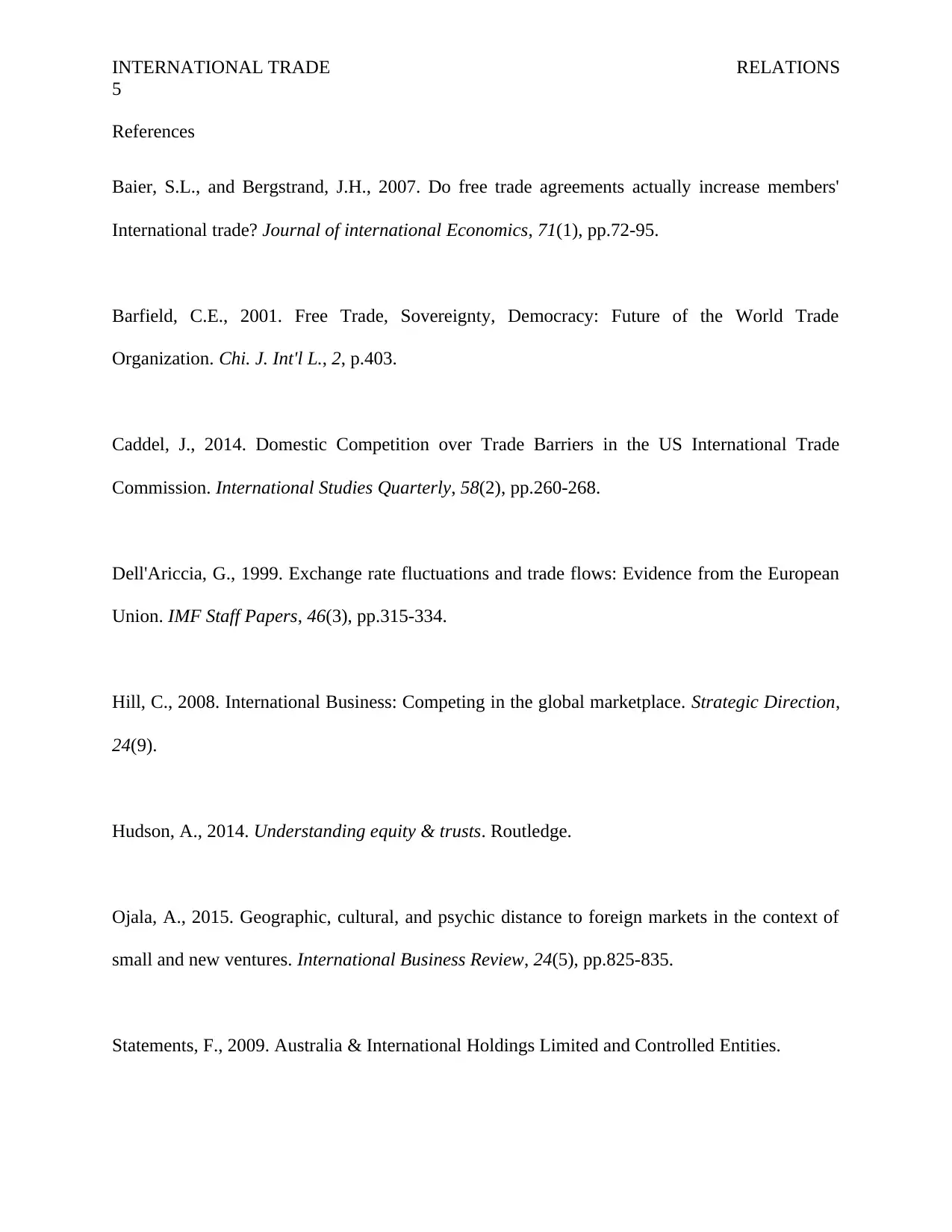
INTERNATIONAL TRADE RELATIONS
5
References
Baier, S.L., and Bergstrand, J.H., 2007. Do free trade agreements actually increase members'
International trade? Journal of international Economics, 71(1), pp.72-95.
Barfield, C.E., 2001. Free Trade, Sovereignty, Democracy: Future of the World Trade
Organization. Chi. J. Int'l L., 2, p.403.
Caddel, J., 2014. Domestic Competition over Trade Barriers in the US International Trade
Commission. International Studies Quarterly, 58(2), pp.260-268.
Dell'Ariccia, G., 1999. Exchange rate fluctuations and trade flows: Evidence from the European
Union. IMF Staff Papers, 46(3), pp.315-334.
Hill, C., 2008. International Business: Competing in the global marketplace. Strategic Direction,
24(9).
Hudson, A., 2014. Understanding equity & trusts. Routledge.
Ojala, A., 2015. Geographic, cultural, and psychic distance to foreign markets in the context of
small and new ventures. International Business Review, 24(5), pp.825-835.
Statements, F., 2009. Australia & International Holdings Limited and Controlled Entities.
5
References
Baier, S.L., and Bergstrand, J.H., 2007. Do free trade agreements actually increase members'
International trade? Journal of international Economics, 71(1), pp.72-95.
Barfield, C.E., 2001. Free Trade, Sovereignty, Democracy: Future of the World Trade
Organization. Chi. J. Int'l L., 2, p.403.
Caddel, J., 2014. Domestic Competition over Trade Barriers in the US International Trade
Commission. International Studies Quarterly, 58(2), pp.260-268.
Dell'Ariccia, G., 1999. Exchange rate fluctuations and trade flows: Evidence from the European
Union. IMF Staff Papers, 46(3), pp.315-334.
Hill, C., 2008. International Business: Competing in the global marketplace. Strategic Direction,
24(9).
Hudson, A., 2014. Understanding equity & trusts. Routledge.
Ojala, A., 2015. Geographic, cultural, and psychic distance to foreign markets in the context of
small and new ventures. International Business Review, 24(5), pp.825-835.
Statements, F., 2009. Australia & International Holdings Limited and Controlled Entities.
1 out of 5
Related Documents
Your All-in-One AI-Powered Toolkit for Academic Success.
+13062052269
info@desklib.com
Available 24*7 on WhatsApp / Email
![[object Object]](/_next/static/media/star-bottom.7253800d.svg)
Unlock your academic potential
Copyright © 2020–2025 A2Z Services. All Rights Reserved. Developed and managed by ZUCOL.





